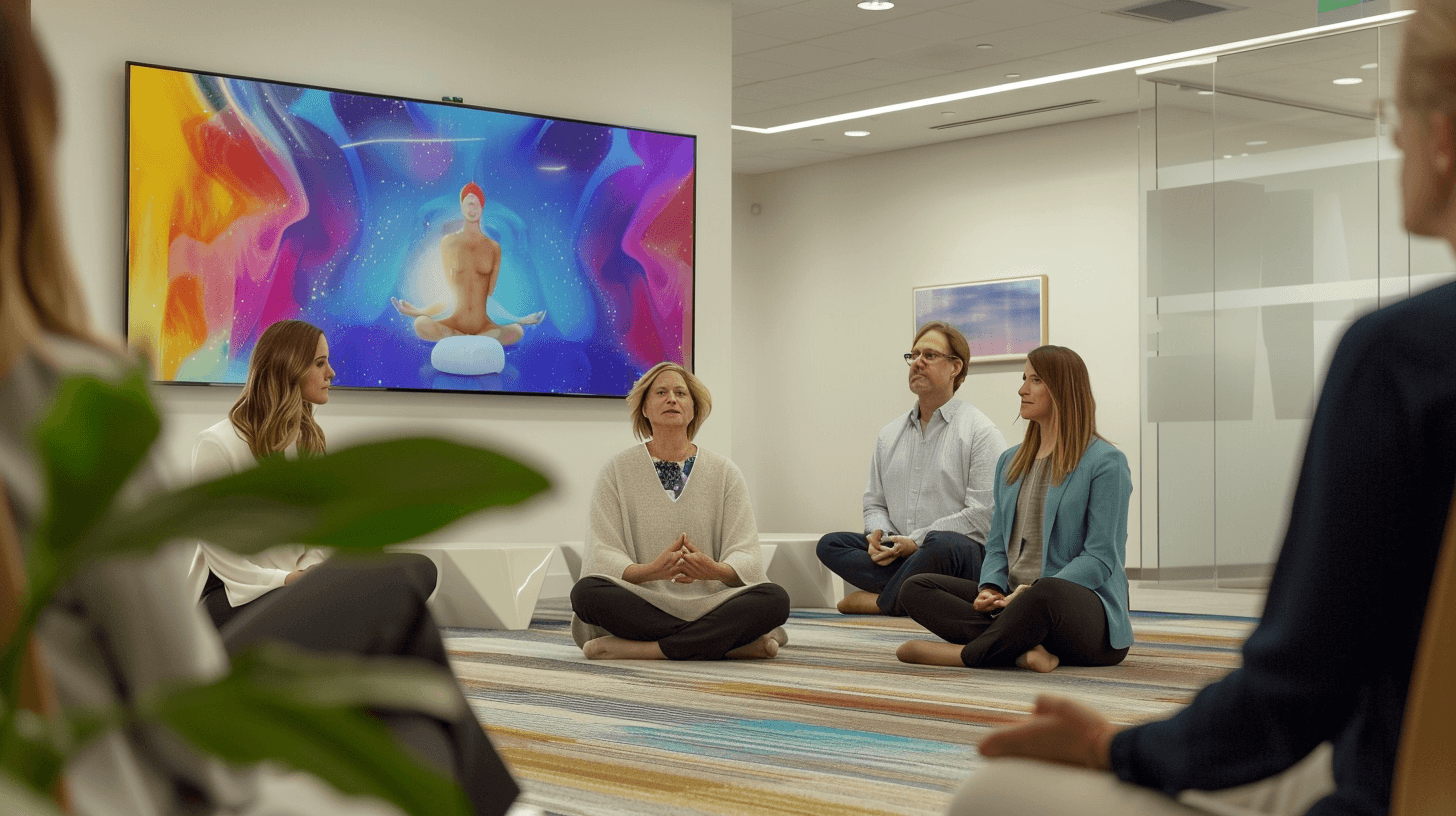Introduction

Stress at work is an all-too-common reality, affecting employees across industries and roles. Tight deadlines, overflowing inboxes, and back-to-back meetings can leave anyone feeling frazzled. The good news? Meditation can be a game-changer, offering practical tools to stay calm, focused, and in control. In this guide, we’ll dive into the causes of workplace stress, the science behind meditation, and some of the most effective meditation programs you can adopt to combat stress in the workplace.
Understanding Workplace Stress: Why It Happens and What’s at Stake

Workplace stress doesn’t just make you feel overwhelmed; it can have far-reaching consequences. Studies reveal that chronic stress can lead to burnout, decreased productivity, and even physical health issues like hypertension, weakened immunity, and heart problems. But why is stress so rampant in professional settings?
Common Causes of Workplace Stress
Unrealistic Workloads: Trying to do too much with too little time often leaves employees feeling inadequate.
Poor Communication: Misunderstandings or lack of clarity in roles and expectations can breed frustration.
Job Insecurity: The fear of layoffs or performance scrutiny can create a persistent undercurrent of anxiety.
Work-Life Imbalance: Juggling professional responsibilities with personal commitments can drain mental energy.
While stress is universal, how we respond to it is within our control. This is where meditation comes in.
How Meditation Works to Reduce Stress

Meditation isn’t just a trendy buzzword—it’s a scientifically proven method for managing stress. It helps shift your brain out of its “fight or flight” mode, which is often triggered by workplace pressures, and into a state of calm and clarity.
The Science of Meditation
Activating the Parasympathetic Nervous System: Meditation encourages deep breathing and relaxation, which signals the brain to calm the stress response.
Reducing Cortisol Levels: Cortisol, the “stress hormone,” is often elevated in stressed individuals. Meditation helps lower its production, reducing anxiety and promoting mental clarity.
Improving Neuroplasticity: Regular meditation strengthens the brain’s ability to adapt and handle challenges by increasing gray matter in areas related to emotion regulation and decision-making.
Top Meditation Programs for Stress Management at Work

Let’s explore some of the most effective and widely recognized meditation programs. These aren’t one-size-fits-all solutions; instead, they offer tailored approaches that you can adapt to your workplace needs.
Mindfulness-Based Stress Reduction (MBSR)
Developed by Dr. Jon Kabat-Zinn at the University of Massachusetts Medical School, MBSR is an eight-week program designed to build mindfulness through meditation and yoga. The goal is to train participants to respond to stress with greater awareness and composure.
How It Works:
Weekly group sessions focus on mindfulness exercises, including body scans and mindful breathing.
Participants practice daily meditation at home using guided recordings.
Why It’s Effective for Workplaces:
Encourages employees to pause and refocus during hectic days.
Provides long-term skills to manage stress beyond the program.
Transcendental Meditation (TM)
If you’ve ever heard about people chanting mantras to achieve zen, they might have been practicing TM. This technique involves silently repeating a specific word or phrase (the mantra) to settle the mind into a state of restful alertness.
How It Works:
Sessions last about 20 minutes, twice a day, and can be done at your desk or in a quiet space.
Unlike mindfulness, TM doesn’t emphasize controlling thoughts but allows the mind to naturally settle into calmness.
Why It’s Perfect for Busy Professionals:
Quick and structured, TM fits easily into a packed schedule.
Research shows it reduces anxiety and improves resilience to stress.
Headspace for Work
Headspace, a leading meditation app, offers workplace solutions tailored to companies. Their guided meditations address stress management, focus, and mindfulness.
What Sets It Apart:
Bite-sized meditation sessions (as short as 5 minutes) make it easy for employees to practice during lunch breaks or between meetings.
Customizable content for specific workplace challenges, such as dealing with difficult coworkers or preparing for big presentations.
Why Companies Love It:
It’s tech-friendly and integrates seamlessly into digital work environments.
Employees can use it anytime, fostering a culture of mindfulness.
Breathworks
Breathworks specializes in mindfulness for managing stress, pain, and chronic conditions. Their programs teach individuals to cultivate compassion and acceptance while navigating life’s challenges.
How It Works:
Combines breathing exercises, meditation, and gentle movement.
Focuses on transforming how people relate to stress, encouraging resilience.
Workplace Applications:
Ideal for high-stress industries like healthcare or finance where burnout rates are high.
Helps employees develop a sense of balance and control.
How to Implement Meditation Programs in Your Workplace

Introducing meditation programs doesn’t have to be an overwhelming process. With the right strategy, you can build a culture of mindfulness that benefits everyone—from top-level executives to new hires.
Step 1: Assess Employee Needs
Every workplace is unique. To ensure the program is effective, start by understanding the specific stressors and preferences of your employees.
Conduct Surveys or Focus Groups: Ask employees about their stress levels, interest in meditation, and preferred formats (e.g., in-person sessions, app-based tools, or workshops).
Analyze Work Environment Stressors: Identify patterns in deadlines, workload spikes, or interpersonal conflicts that could influence stress levels.
Step 2: Choose the Right Program
Based on employee feedback, select a program that aligns with your organization’s culture and logistics. For example:
Busy Corporate Teams: Opt for quick, app-based solutions like Headspace or Calm.
Chronic Stress or Burnout: Programs like MBSR or Breathworks are designed for deeper, long-term transformation.
Creative Teams or High-Stress Roles: Transcendental Meditation can help employees tap into calmness and creativity.
Step 3: Make Participation Accessible
The key to success is ensuring that employees feel encouraged—not obligated—to participate.
Offer Flexible Options: Provide lunchtime sessions, post-work classes, or access to apps for self-guided practice.
Designate a Quiet Space: Transform an unused office or meeting room into a mindfulness corner where employees can meditate during breaks.
Provide Resources: Offer books, videos, or links to online meditations to help employees get started.
Overcoming Challenges in Adopting Meditation Practices

Even with the best intentions, introducing meditation programs may encounter resistance. Here’s how to navigate common obstacles:
Challenge 1: Employee Skepticism
Not everyone is immediately receptive to meditation. Some employees may view it as a “soft” practice or feel awkward participating.
Solution:
Start small. Introduce mindfulness exercises during team meetings or offer short guided sessions to ease them in.
Share success stories from other companies. Highlight how Google, Salesforce, or General Mills have used meditation to improve productivity and reduce burnout.
Challenge 2: Time Constraints
In fast-paced work environments, employees may struggle to carve out time for meditation.
Solution:
Keep sessions short—5 to 10 minutes is enough to reset the mind.
Emphasize flexibility. Let employees know they can practice on their own schedule, whether it’s before work, during a break, or at the end of the day.
Challenge 3: Sustaining Momentum
Initial enthusiasm can fizzle out without ongoing support.
Solution:
Appoint mindfulness champions—employees who can lead by example and encourage others to participate.
Regularly update offerings to keep them fresh and engaging, such as introducing new guided meditations or hosting guest speakers.
Long-Term Benefits of Workplace Meditation

When meditation becomes a regular part of the workplace, the benefits extend far beyond stress management. Over time, you’ll notice profound shifts in how employees approach challenges and collaborate.
Boosted Focus and Productivity
Meditation enhances concentration by training the brain to tune out distractions. Employees who meditate regularly often report being able to tackle complex tasks more efficiently.
Improved Emotional Intelligence
Mindfulness fosters empathy and emotional regulation, helping employees navigate interpersonal conflicts with greater ease. This can improve team dynamics and create a more harmonious work environment.
Enhanced Creativity
For industries that thrive on innovation, meditation can unlock creative potential. Practices like Transcendental Meditation have been shown to increase divergent thinking—the ability to generate unique ideas and solutions.
Reduced Absenteeism
Chronic stress often leads to physical illness and burnout, resulting in missed workdays. By mitigating stress, meditation programs contribute to healthier, more resilient employees.
Meditation Success Stories: Real-World Examples

Google: Google’s “Search Inside Yourself” program combines mindfulness and emotional intelligence training to help employees manage stress and improve leadership skills. The initiative has been a cornerstone of Google’s wellness strategy.
General Mills: The food giant created dedicated mindfulness rooms and integrated meditation into leadership development programs. Leaders who participated reported being more effective at handling workplace stress.
Salesforce: Salesforce offers guided meditations through its employee wellness platform, helping team members stay grounded and productive in a high-pressure tech environment.
Conclusion: Your Next Step Toward a Stress-Free Workplace

Incorporating meditation into your workplace isn’t just about reducing stress—it’s about empowering your team to thrive. From bite-sized mindfulness breaks to immersive programs like MBSR, there’s no shortage of options to get started.
Ready to make mindfulness a part of your work culture? Start small. Choose a program that resonates with your team, provide the tools they need, and watch as stress melts away, creativity flourishes, and productivity soars.
Explore More: If you found this guide helpful, we’ve got more expert insights waiting for you. Dive into our library of articles to discover actionable strategies for workplace well-being and beyond!







